The Fatty Alcohol Market is expected to register a CAGR of 6% from 2025 to 2031, with a market size expanding from US$ XX million in 2024 to US$ XX Million by 2031.
Fatty Alcohol Market covers analysis By Type (Pure and Mid-Cut, Short Chain, Long Chain, and Others), and Application (Detergents, Personal Care and Cosmetics, Pharmaceuticals, Food and Beverages, Plasticizers, and Others) and Geography (North America Europe, Asia Pacific, Middle East and Africa, and South and Central America). Fatty alcohol is mainly used to produce detergents and surfactants. Consumers are more aware of using eco-friendly items because of growing environmental concerns. In comparison to petrochemicals, fatty alcohols are preferred for the production of cosmetics and personal care goods.
Purpose of the Report
The report Fatty Alcohol Market by The Insight Partners aims to describe the present landscape and future growth, top driving factors, challenges, and opportunities. This will provide insights to various business stakeholders, such as:
- Technology Providers/Manufacturers: To understand the evolving market dynamics and know the potential growth opportunities, enabling them to make informed strategic decisions.
- Investors: To conduct a comprehensive trend analysis regarding the market growth rate, market financial projections, and opportunities that exist across the value chain.
- Regulatory bodies: To regulate policies and police activities in the market with the aim of minimizing abuse, preserving investor trust and confidence, and upholding the integrity and stability of the market.
Fatty Alcohol Market Segmentation
Type
- Pure and Mid-Cut
- Short Chain
- Long Chain
Application
- Detergents
- Personal Care and Cosmetics
- Pharmaceuticals
- Food and Beverages
- Plasticizers
You will get customization on any report - free of charge - including parts of this report, or country-level analysis, Excel Data pack, as well as avail great offers and discounts for start-ups & universities
Fatty Alcohol Market: Strategic Insights
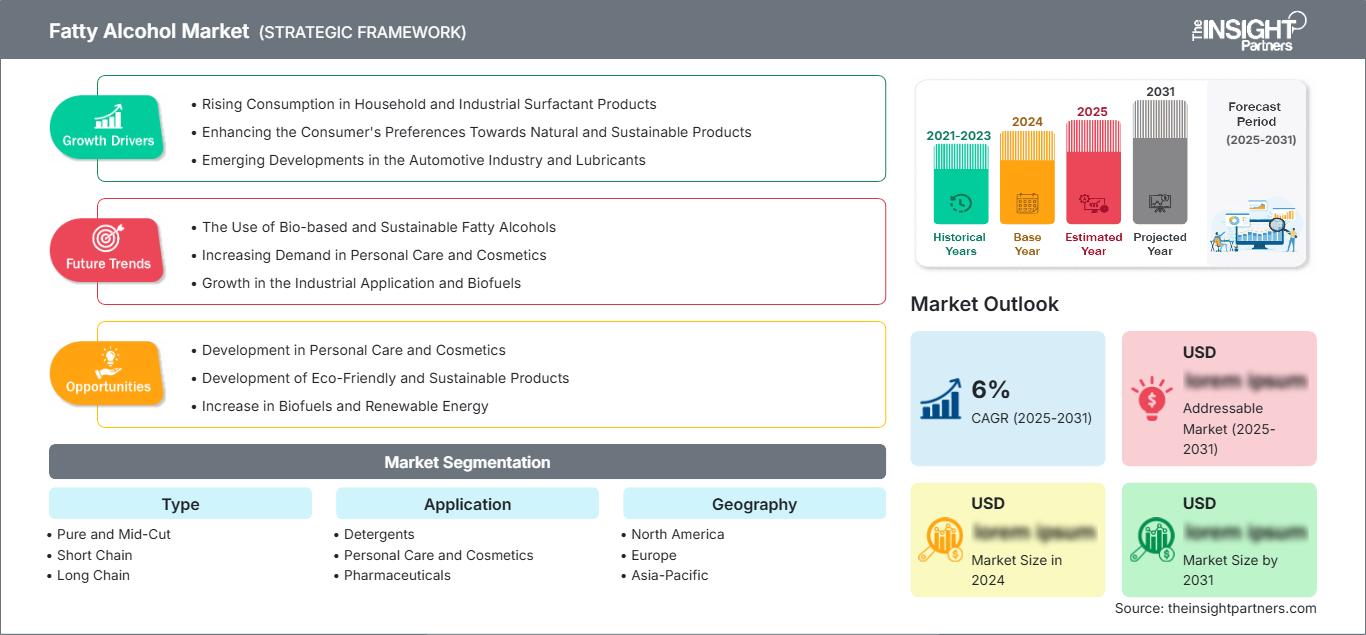
-
Get Top Key Market Trends of this report.This FREE sample will include data analysis, ranging from market trends to estimates and forecasts.
Fatty Alcohol Market Growth Drivers
- Rising Consumption in Household and Industrial Surfactant Products: The use of fatty alcohols in surfactants and their application in household cleaning agents, detergents, as well as their industrial applications are the keys that promise a bright future for the market. Increasing consumer demand for highly efficient, eco-friendly, and biodegradable cleaning agents drives the demand for fatty alcohol-derived surfactants; hence, the market is projected to grow.
- Enhancing the Consumer's Preferences Towards Natural and Sustainable Products: The increased demand for natural and sustainable products is as much a consumer reaction as it is a consumer demand. Fatty alcohols must thus find adhesion and application in personal care products, cosmetics, and biodegradable formulations, since these products come from renewable plant oils, for example, palm and coconut now in line with some new trend.
- Emerging Developments in the Automotive Industry and Lubricants: The manufacturers of fatty alcohols provide increasing amounts for production of lubricants, plasticizers, and waxes. These products are increasingly important for the automotive industry and major vehicle manufacturers, which continue to focus on high-performance, green lubricants. Hence, it is evident that fatty alcohols will only have an increasing demand in these applications and prospects for playing a pronounced role in expanding opportunities in the market.
Fatty Alcohol Market Future Trends
- The Use of Bio-based and Sustainable Fatty Alcohols: The movement toward fatty alcohols produced using renewable raw materials such as palm oil and coconut oil tends to be increasing. The development is by increasing consumer preference for using such products for example in personal care, cleaning, and biofuels while going along with international environmental requirements for sustainably produced products.
- Increasing Demand in Personal Care and Cosmetics: With the advent of personal care and cosmetics, fatty alcohols emitted are used as emulsifiers, moisturizers, and surfactants. People use surface active agents to bring something more natural and effective, so the demand for fatty alcohol formulation bases in shampoos, lotions, and creams is on the rise.
- Growth in the Industrial Application and Biofuels: Fatty alcohols are increasingly used for and in various industrial applications, including lubricants and plasticizers, as well as biofuels. The expanding market demand for eco-friendliness and biodegradability among these segments is encouraging growth in these markets, where manufacturing companies are looking for alternatives to petroleum-based chemicals and products having a lesser environmental impact.
Fatty Alcohol Market Opportunities
- Development in Personal Care and Cosmetics: One of the potential opportunities for fatty alcohols is in personal care, where there is a growing preference for natural and organic products. Fatty alcohols used in moisturizers, shampoos, and conditioners-rich formulations are consistent with this consumer trend,' adding gentle, natural ingredients to beauty and personal care.
- Development of Eco-Friendly and Sustainable Products: As consumers and industries become increasingly concerned with sustainability, the opportunity for fatty alcohols derived from renewable sources increases. Due to their biodegradability and low environmental impact, sources of natural origin become ideal small ingredients for green products, creating market niches to open up in cleaner sectors such as cleaning and packaging.
- Increase in Biofuels and Renewable Energy : Fatty alcohols are forecast to gain momentum in the production of biodiesel and other forms of biofuels. With global adoptation of renewable energy sources increasingly becoming tight for everyone, using fatty alcohols from the oils of plants presents a major opportunity for growth because governments and industries encourage cleaner and more sustainable alternatives.
Fatty Alcohol Market Regional Insights
The regional trends and factors influencing the Fatty Alcohol Market throughout the forecast period have been thoroughly explained by the analysts at The Insight Partners. This section also discusses Fatty Alcohol Market segments and geography across North America, Europe, Asia Pacific, Middle East and Africa, and South and Central America.
Fatty Alcohol Market Report Scope
| Report Attribute | Details |
|---|---|
| Market size in 2024 | US$ XX million |
| Market Size by 2031 | US$ XX Million |
| Global CAGR (2025 - 2031) | 6% |
| Historical Data | 2021-2023 |
| Forecast period | 2025-2031 |
| Segments Covered |
By Type
|
| Regions and Countries Covered |
North America
|
| Market leaders and key company profiles |
|
Fatty Alcohol Market Players Density: Understanding Its Impact on Business Dynamics
The Fatty Alcohol Market is growing rapidly, driven by increasing end-user demand due to factors such as evolving consumer preferences, technological advancements, and greater awareness of the product's benefits. As demand rises, businesses are expanding their offerings, innovating to meet consumer needs, and capitalizing on emerging trends, which further fuels market growth.
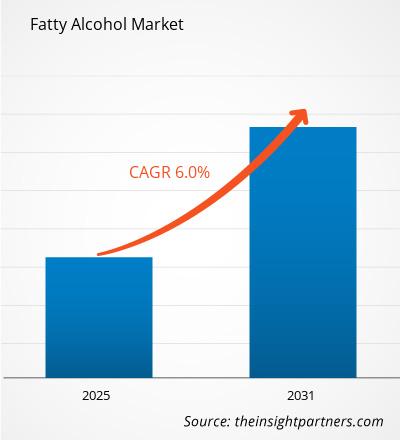
- Get the Fatty Alcohol Market top key players overview
Key Selling Points
- Comprehensive Coverage: The report comprehensively covers the analysis of products, services, types, and end users of the Fatty Alcohol Market, providing a holistic landscape.
- Expert Analysis: The report is compiled based on the in-depth understanding of industry experts and analysts.
- Up-to-date Information: The report assures business relevance due to its coverage of recent information and data trends.
- Customization Options: This report can be customized to cater to specific client requirements and suit the business strategies aptly.
The research report on the Fatty Alcohol Market can, therefore, help spearhead the trail of decoding and understanding the industry scenario and growth prospects. Although there can be a few valid concerns, the overall benefits of this report tend to outweigh the disadvantages.
Frequently Asked Questions
What are the future trends in the market?
Based on geography, which region is expected to record a highest CAGR in the market.
Which application segment accounted for the highest share in the fatty alcohol market?
What are the driving factors impacting the fatty alcohol market?
What are the key players operating in the fatty alcohol market?
What is the expected CAGR of the Fatty Alcohol Market ?
- Historical Analysis (2 Years), Base Year, Forecast (7 Years) with CAGR
- PEST and SWOT Analysis
- Market Size Value / Volume - Global, Regional, Country
- Industry and Competitive Landscape
- Excel Dataset
Recent Reports
Related Reports
Testimonials
Reason to Buy
- Informed Decision-Making
- Understanding Market Dynamics
- Competitive Analysis
- Identifying Emerging Markets
- Customer Insights
- Market Forecasts
- Risk Mitigation
- Boosting Operational Efficiency
- Strategic Planning
- Investment Justification
- Tracking Industry Innovations
- Aligning with Regulatory Trends












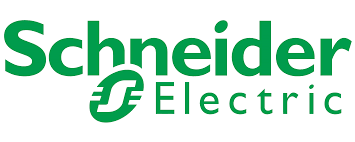


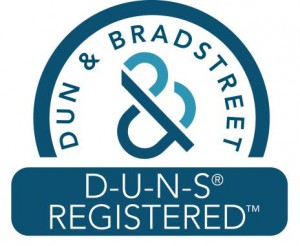
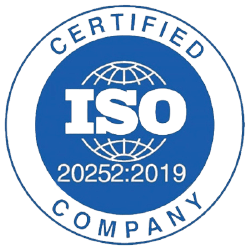
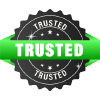



 Get Free Sample For
Get Free Sample For